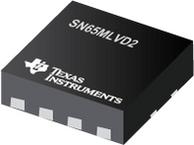●The SN65MLVD2 and SN65MLVD3 are single-channel M-LVDS receivers. These devices are designed in full compliance with the TIA/EIA-899 (M-LVDS) standard, which are optimized to operate at signaling rates up to 250 Mbps. Each receiver channel is controlled by a receive enable (RE). When RE = low, the corresponding channel is enabled; when RE = high, the corresponding channel is disabled.
●The M-LVDS standard defines two types of receivers, designated as Type-1 and Type-2. Type-1 receivers (SN65MLVD2) have thresholds centered about zero with 25 mV of hysteresis to prevent output oscillations with loss of input; Type-2 receivers (SN65MLVD3) implement a failsafe by using an offset threshold. Receiver outputs are slew rate controlled to reduce EMI and crosstalk effects associated with large current surges.
●The devices are characterized for operation from -40°C to 85°C.
● Low-Voltage Differential 30- Line Receivers for Signaling Rates(1) up to 250Mbps; Clock Frequencies up to 125MHz
● SN65MLVD2 Type-1 Receiver Incorporates 25 mV of Input Threshold Hysteresis
● SN65MLVD3 Type-2 Receiver Provides 100 mV Offset Threshold to Detect Open-Circuit and Idle-Bus Conditions
● Wide Receiver Input Common-Mode Voltage Range, -1 V to 3.4 V, Allows 2 V of Ground Noise
● Improved VIT (35 mV)
● Meets or Exceeds the M-LVDS Standard TIA/EIA-899 for Multipoint Topology
● High Input Impedance with Low Supply Voltage
● Bus-Pin HBM ESD Protection Exceeds 9 kV
● Packaged in 8-Pin SON (DRB) 70% Smaller Than 8-Pin SOIC
● APPLICATIONS
● Parallel Multipoint Data and Clock Transmission via Backplanes and Cables
● Cellular Base Stations
● Central Office Switches
● Network Switches and Routers
●(1) The signaling rate of a line is the number of voltage transitions that are made per second, expressed in the units bps (bits per second).



